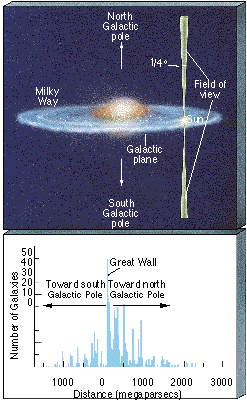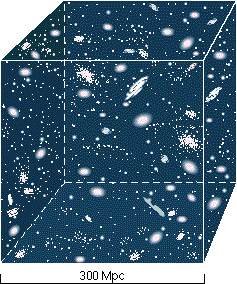The universe shows structure on every scale we have examined so far. Subatomic particles form nuclei and atoms. Atoms form planets and stars. Stars form star clusters and galaxies. Galaxies form galaxy clusters, superclusters, and even larger structures—voids, filaments and sheets that stretch across the sky. From the quarks in a proton to the galaxies in the Great Wall, we can trace a hierarchy of "clustering" of matter from the very smallest to the very largest scales. It is natural to ask: Does the clustering ever end? Is there some scale on which the universe can be regarded as more or less smooth and featureless? Perhaps surprisingly, given the trend we have just described, most astronomers think the answer is yes.
We saw in Chapter 24 how surveys of the universe have revealed the existence of structures as large as 200 Mpc across. (Sec. 24.5) Yet, although they cover wide areas of the sky and enormous volumes of space, these studies are still relatively "local," in the sense that they span only a few percent of the distance to the farthest quasars (which lie over 5000 Mpc from Earth). A major obstacle to extending these wide-angle surveys to much greater distances is the sheer observational effort of measuring the redshifts of all the galaxies within larger and larger volumes of space.
An alternative approach is to narrow the field of view to only a few small patches of the sky but to study very distant galaxies within those patches. The volume surveyed then becomes a long, thin "pencil beam" extending deep into space rather than a wide swath through the local universe. Figure 26.1 presents the results of one such survey, showing the distribution of galaxies in two directions perpendicular to the plane of our Galaxy, out to a distance of about 2000 Mpc.

Figure 26.1 The results of a deep "pencil-beam" survey of two small portions of the sky in opposite directions from Earth perpendicular to the Galactic plane. The graph shows the number of galaxies at different distances from us, out to a distance of about 2000 Mpc. The distinctive "picket fence" appearance seems to show voids and sheets of galaxies on scales of 100 or 200 Mpc but gives no indication of any larger structure.
Although the numbers of galaxies fall off at large distances—mainly because very distant galaxies are very hard to see—a distinctive "on—off" pattern of galaxies, looking a little like a picket fence, can be seen. It is thought that the gaps between the "pickets" are voids like those seen closer to home and that the pickets themselves are places where the line of sight intersects sheets like the Great Wall. The data seem to indicate that the largest structures in the local universe are only 100𤺠200 Mpc across—no voids or clumps of galaxies much larger than that are seen. In short, there is presently no evidence for structure in the universe on scales greater than about 200 Mpc. Interlude 26-1 discusses a recent very deep survey that has generated a great deal of excitement among astronomers.
On the basis of these rather sketchy data, theoretical insight, and not a little philosophical preference, cosmologists—astronomers who study the large-scale structure and dynamics of the universe—assume that the universe is roughly homogeneous on scales greater than a few hundred megaparsecs. In other words, if we imagine taking a huge cube𤼄300 Mpc on a side, say—and placing it anywhere in the universe, as illustrated in Figure 26.2, the number of galaxies it enclosed would be pretty much the same—around 100,000, excluding the faint dwarf ellipticals and irregulars—no matter where in the universe we put it. Some of the galaxies would be clustered and clumped into fairly large structures, and some would not, but the total number would not vary much as the cube was moved from place to place. In short, the universe looks smooth on the largest scales.

Figure 26.2 Diagram of galaxies contained within an enormous cube, 300 Mpc on a side. Cosmologists believe that the contents of such a cube would look pretty much the same no matter where we placed the cube in the universe. (not drawn to scale; for accurate scaling see the deep-space photos in Figures 24.18, 24.23, and 24.24.)
Cosmic homogeneity is the first of two major assumptions that cosmologists make when studying the large-scale structure of the universe. Observations suggest that it is true, but it is by no means proven. The second assumption, also supported by observational evidence and theoretical reasoning, is that the universe is isotropic—that is, it looks the same in any direction. Isotropy is on much firmer observational ground than homogeneity. Apart from regions of the sky that are obscured by our Galaxy, the universe does look much the same in all directions, at any wavelength, provided we look far enough. In other words, any deep pencil-beam survey of the sky should count about the same number of galaxies as the study mentioned previously, regardless of which patch of the sky is chosen.
The assumptions of homogeneity and isotropy form the foundation of modern cosmology—the study of the structure and evolution of the entire universe. Together, these twin pillars of cosmology are known as the cosmological principle. No one really knows if this principle is absolutely correct. All that we can say is that, so far, it seems consistent with observations. From this point on we will simply assume that it holds—at least on large enough scales. Should it turn out to be incorrect—for example, were a structure a few thousand megaparsecs across to be discovered tomorrow—then some of the discussion that follows would be on very shaky ground indeed!
The cosmological principle has very far reaching implications. For example, it implies that there can be no edge to the universe, because that would violate the assumption of homogeneity. Furthermore, it implies that there is no center, because that would mean that the universe would not be the same in all directions from any noncentral point, a violation of the assumption of isotropy. Thus, this single principle strongly limits what the overall geometry of the universe can be. The cosmological principle is the ultimate expression of the principle of mediocrity. It states not only that are we not central to the universe but that no one can be central, because the universe has no center!